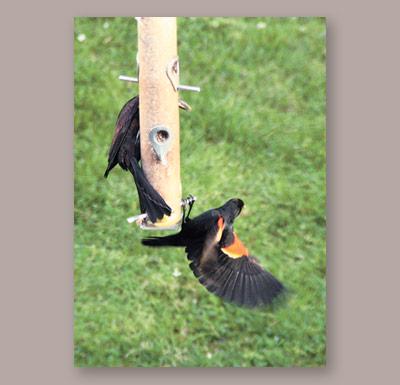Nature Notes: Heralding Fall

The leaves are beginning to color up. The tupelos, dogwoods, red maples, and sassafras are always the first to turn. The tupelo-lined edges of Little Northwest Creek just east of Sag Harbor are turning burgundy. Having experienced the drying and salt-laden winds of Irene, I wonder, will we have a pretty fall or a drabbish one?
As you may have noticed, the robins are flying around in loose groups as they hunt for berries and other food before picking up and going south. Grackles and red-winged blackbirds are beginning to fly around in mixed flocks. Adult crows, after raising their families, are no longer seen in pairs, but in large groups as they eye the cornstalks tanning in the fields.
The cicadas and tree crickets are still stridulating at night, but with much less volume than in the middle of August when the temperature was in the 80s. The katydid’s “Katy did, Katy didn’t” has become slurred and dragged out as its song is temperature dependent, both in pitch and tempo. Around freshwater ponds, one hears the occasional fall song of the spring peeper, a call not to reproduce but to get underground as winter and freezing temperatures will soon be on their way. Frogs and box turtles caught out in the open during a freeze are likely to become nonsurvivors.
The Carolina wren in the backyard has started singing again. It is one of the few birds that sings off and on throughout the year while it maintains its more or less permanent territory. The mockingbird is another, especially in areas where there are abundant rosehips and other fruit that persist into the winter.
The witch hazel in Montauk’s Point Woods, a mile west of the Lighthouse, is beginning to bloom.
It is one of those rare tree species that saves its flowering until after summer at a time when the other trees are ripening up fruit. Thusly, it has the bees and the other insect pollinators that frequent woodlands all to itself.
You may have noticed acorns from one or more of our several native oak species hitting the roof at night with a clunk. Thus far it’s a so-so acorn year. The deer and turkeys are waiting eagerly for more to fall; the chipmunks and white-footed mice are scrambling to harvest their share and cache them in some secret hiding place.
In the salt marshes the fiddler crabs are beginning to chink in their holes from below. They will spend winter underground in hopes of surviving until April when they open up their sodden lairs and begin to pop out.
Double-crested cormorants are still drying their wings while sitting on fish raps throughout the Peconics, but soon will be forming into V or straight-line skeins and heading south. Geese from the north that overwinter here should be filling the skies with their cries any day now. Most of the honking will emanate from Canada geese, but if we are in the right place at the right time, we could pick out the squeakier honks of the snow geese that are infrequent in Long Island skies. Mallards are gathering in Otter Pond, Pussy’s Pond, East Hampton Village’s Nature Trail stream, and other local waterfowl wintering areas, where they are confident that kind souls will feed and shepherd them through the cold months.
At the upper edge of salt marshes the groundsel bush or sea myrtle is flowering white and fluffy. It is one of the few local members of the sunflower family that is a shrub and not a wildflower. Every fall at this time it lights up the marsh. Those who identify and map saltwater wetlands for a living merely have to drive along and without leaving their vehicles can observe their misty whitened edges.
Yes, ticks and chiggers also like the fall. [Please see editor's note below.] They are still out in droves, especially the larval deer and Lone Star ticks, which are popping out of eggs at this time. On the other hand, mosquitoes are becoming scarce, so walks at night along roads on Napeague and other low-lying areas have become tolerable without the benefit of Deet or other repellents.
Cranberries are ripening in the bogs. Enjoy.
—
Editor's note: The presence of chiggers on Long Island has been consistently disputed by entomologists; no evidence for a population here has been found.
